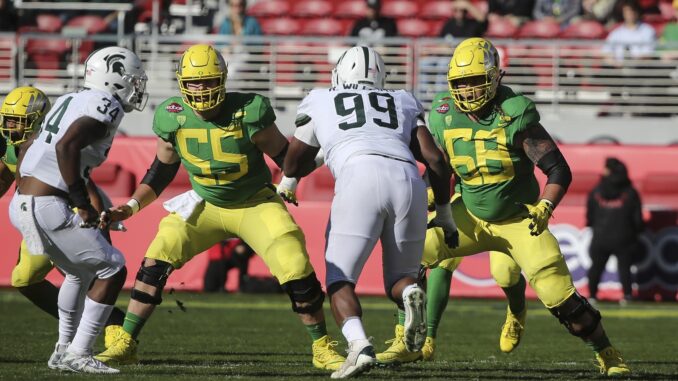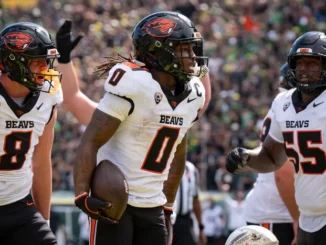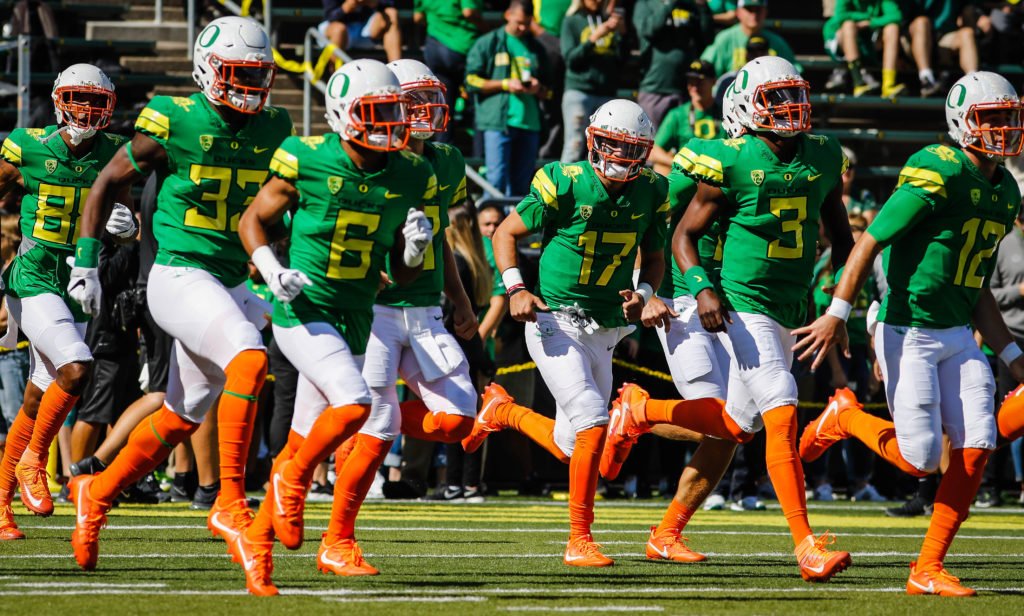
Although there is still a lot of activity in and out of the transfer portal, offensive linemen across the nation seemed settled enough that we can get a pretty good idea of what to expect for most teams.
There are some “fanalysts” (fans and analysts) who don’t believe there is a reliable method for projecting offensive line effectiveness. In recent years, I’ve come to believe we can make those projections.
Before we get into discussing PAC-12 offensive lines, we need to acknowledge that your definition of a returning starter won’t always agree with mine because we tend to place different values on things.
For example, if you had a player who won the starting job at the beginning of last year but went down with an injury after just a few games, would you consider him the true starter and not his replacement who couldn’t win the job outright?
What if your starter this year transferred in from a lesser school? Should he be considered a returning starter because he won the job at a lesser school?
While there are many enigmatic examples we could discuss, let’s end on this one: If you have a lineman who started every game, but his understudy actually played more minutes, then who is your starter?
I’ve found a simple method for separating starters from subs, but rather than discuss that, let’s get to our task for the day, projecting the effectiveness of PAC-12 offensive lines in the 2021 season. We’ll look first at the South Division, then the North.
I will have a more comprehensive preview of offensive lines later at savvygameline.com.
PAC-12 SOUTH
6. ARIZONA
I believe the Wildcat offensive line was better last year than statistics suggest. It seemed to me that U of A generally played worse with each game and that coach Kevin Sumlin had lost the confidence of his players. That notion was validated when the season ended with a seven-turnover thud and a 70-7 loss at home to arch-rival Arizona State.
‘Cat backs were able to get 4.2 yards per game, so there was some display of blocking talent, but the schemes used to deflect pressure didn’t work. Consequently, Wildcat fans watched their Wildcats get caught in their own backfield more than one time for every seven plays. Consequently, Wildcat fans watched their Wildcats get caught in their own backfield more than one time for every seven plays.
Overall, Arizona’s offensive line ranked 118th in the nation and 12th in the PAC-12 for blocking for the run and the pass. With four starters and three top subs returning, the offensive line will be better, but so will most of U of A’s opponents. And, there is going to be an issue with depth, so the ‘Cats cannot afford injuries.
Only by making some huge strides will this group avert finishing as the PAC-12’s worst line for the second straight season.
5th COLORADO
Colorado’s offensive front was better than average in 2020 and will be slightly better in 2021. The Buffaloes line was about average in rush blocking and finished 12th nationally for protecting quarterbacks.
Although Colorado won’t win as often this season, the line should hold up well and finish near the middle of the pack for overall blocking effectiveness.
The concerns I have for this group is that it still has a short rotation and it was sporadic in dealing with run blitzes.
4th UCLA
I was surprised to see the Savvy Index rank UCLA’s offensive line this low because I have a pretty high opinion of what the Bruins will accomplish this year and because all ten of the top linemen return from last year.
The Bruin offensive line ran hot and cold last season. It blocked well enough to produce the nation’s 26th-best yards per carry rush attack, but it ranked 84th nationally in stopping tackles for loss. Since UCLA will run the ball more than 60% of the time, keeping opponents out of the backfield is going to be vital.
The Bruin offensive line has depth and experience, but it won’t be any better than fourth in the South until it shows it can deal with pressure.
3rd USC
I’m sure you’ve heard the outcry that USC’s offensive line was near the bottom of the PAC-12 last season.
When it comes to run blocking, I agree. Trojan running backs could only manage 3.1 yards per carry which ranked 118th in the FBS. The Trojan line also ranked 102nd for letting runners get caught in their own backfield. I don’t suppose it’s a surprise that two running backs were transferred to other programs.
Despite those problems, USC won the PAC-12 South because the Trojans’ passing and pass blocking were better than average. But, just being better than average won’t be enough for this team to reach the national playoff. In fact, it might not even be enough to hold off Utah for the PAC-12 South crown.
There is an expectation of improvement in 2021 because USC has a new offensive line coach and because only Alijah Vera-Tucker is gone from the top ten blockers. Still, this group is projected to be only third-best in the South and outside of the top 25 nationally.
2nd ARIZONA STATE
The Sun Devils have done a good job of building their offensive line talent, mostly through the transfer portal (thank you, Stanford), and that talent may be among the 25 best in the nation.
The Arizona State line blocked well enough for running backs to produce 6.4 yards per carry in an abbreviated season. Arizona State ranked 12th nationally for rush blocking between basic blocking and dealing with pressure.
Pass blocking ranked 10th in the PAC-12 in 2020, but some of that problem can be attributed to ASU’s long-ball passing scheme that requires linemen to hold blocks longer than most.
The good news for ASU is that it returns everyone except starting center Cade Cote who opted out of a seventh year. Plus, the Sun Devil line is young. Seven of the top ten returners have a combined 23 years of remaining eligibility. If stacked end-to-end, we wouldn’t see the last of them until 2044
1st UTAH
Utah returns All PAC-12 linemen Nick Ford and Orlando Umana and all eight of its other two deeps. The starting five are all over 300 pounds and have combined for 98 starts. Clearly, this group will be even better than last year when it opened holes for running backs to get nearly six yards per carry and was one of the best in America for protecting quarterbacks.
There is some concern that only one lineman was recruited in the 2021 cycle, and he is at least 40 pounds underweight and will likely be red-shirted.
However, recruiting skeptics must keep in mind that Utah’s offensive line depth chart consists of three freshmen, four sophomores, and just one senior.
The advantage that Utah has over USC in offensive lines is reason enough to think the Utes could win the PAC-12 South title.
PAC-12 NORTH
6th CALIFORNIA
The Bears finished 110th in the nation for scoring offense in 2020 and the offensive line was a big part of the problem.
I think most of us would expect a line that returns nine of its top ten blockers would be pretty good, but the dismal performance of this line makes it seem that fewer returners might actually be a benefit.
Cal finished 117th nationally in rush blocking and 116th in the number of sacks per passing attempt between basic blocking and dealing with pressure. In fact, Cal’s pass protection was so bad that it yielded one sack for every nine pass attempts.
Except for a game against UCLA, all of California’s losses were by a single possession that would have reversed had the offensive line not suffered in red-zone possessions.
There are no new incoming stars for this unit, so, except Arizona, this will be the weakest line in the PAC-12.
5th WASHINGTON STATE
The Cougars rank between 51st and 55th nationally in nearly all of the results from the Savvy Index criteria. While that performance is in the top half of FBS as a whole, it’s only ninth-best in the PAC-12.
In addition, WSU ranks only ninth in the PAC-12 for returning linemen and now faces a crucial depth problem after starting right guard Josh Watson. His top replacement Hunter Mayginnes elected not to return.
Compounding that problem is that no linemen are transferring into Washington State, and the only lineman the Cougars recruited is underweight and didn’t make last month’s depth chart.
Washington State has decent talent in its offensive line, just not enough of it.
4th STANFORD
Stanford will start five huge linemen from an offensive line that performed well last season. However, this is probably the last year we can say that because, after these seniors graduate, the stable of snorting behemoths will be mostly bare.
Once upon a time, those mammoths were drawn to The Farm, but lately, it has been where they have transferred, many of them to Arizona State. What remains is three starters, two top subs moving up, and only one sub from last year to provide depth.
Coach David Shaw has not brought help from the portal and his recruiting netted only two line recruits. Only one is a four-star, and neither breaks 280 on the scales. Clearly, if any of the beasts upfront go lame, the Stanford offense will go south in a hurry.
Although the Savvy system ranks this offensive line fourth in the North, I personally think it is more likely to finish lower.
3rd OREGON STATE
The Beavers’ offensive line surprised me in the shortened 2020 season. It blocked well enough for Oregon State to produce the 19th best yards-per-carry by running backs, and it ranked 13th-for not allowing tackles for loss.
In addition, it helped produce one of the nation’s top fourth-down conversion ratios, delivered scores on 25 of 28 red zone attempts, and it finished in the top one-third of the nation’s pass protection lines.
The work that line coach Jim Michalczik has done with this group has been magnificent. Since his arrival in 2018, OSU scoring had averaged 28.7 ppg compared to the three years before when it averaged less than 22.
And now, Michalczik has his entire set of starters back plus three reserves, so Beaver fans can expect a strong showing from this group.
2nd OREGON
Despite a major rebuild, the Oregon offensive line was serviceable last year. Great talent was on display but then so was inexperience.
The Ducks finished in the top one-third of the nation for basic blocking and in the top one-half for dealing with pressure which is impressive when we acknowledge that Oregon was one of the most committed long-ball passing teams in the country. It takes time to get receivers downfield, and the Duck line handled it well.
Based primarily on Oregon returning all five starters and the projected potential of those starters, my Savvy system ranks Oregon as the PAC-12 team with the biggest upside for improvement from last year to this.
What is concerning right now is that the Ducks had only identified Steven Jones as a backup as late as Memorial Day. Jones has plenty of ability and experience, but Oregon needs to figure out who the other four will be.
1st WASHINGTON
Washington’s offensive line was slightly better than average in basic blocking, but it was the best in America in dealing with pressure and critical situations.
The Husky line could only get running backs to 4.5 yards per rush (61st nationally) but it excelled in critical downs, red zone scoring, and picking up both run and pass blitzes (2nd nationally in both).
Even better, offensive line coach Scott Huff has done a fabulous job bringing in new talent. His recruiting acumen was shown again yesterday with the signing of Mark Nabou, a top-30 lineman recruit.
The entire offensive starting line and all five top subs return for the 2021 season, making this the top returning offensive line in the PAC-12 and one of the ten best in the nation.




